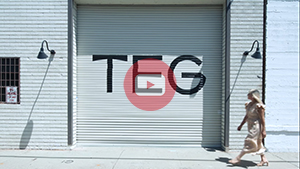Paula Bradley: Creating Rock 'n' Roll Style
British expatriate Paula Bradley is a stylist with a rock ’n’ roll past.
The stylist and designer’s creations helped to shape the look of such iconic ’80s musicians as Duran Duran, Depeche Mode and Sineacute;ad O’Connor.
These days, the stylist and designer is creating, with the help of partner Matt Goldman, the look of the Pussycat Dolls, the sizzling hot burlesque dancers turned pop-music and dance troupe.
Bradley didn’t set out with rock ’n’ roll in mind. She studied fashion design and textiles at Middlesex College in north London and then earned a master’s degree at the prestigious Royal College of Art in London.
After graduating, she says she “fell into” co-designing stage clothes for O’Connor and the members of Duran Duran and Depeche Mode.
“At that time the rock industry was very, very separate from the fashion industry and the fashion industry wasn’t very interested in the rock industry,” Bradley said. “It was a great opportunity to be really creative for a client who could pay for it, which was rare.” She then went on tour with Depeche Mode and Phil Collins, which she says was an eye-opening learning experience. “Traveling really opened and broadened my mind,” Bradley said. “I got to see the world, and suddenly fashion seemed very small.”
She handled wardrobe on the tour, but her job included hospitality and taking care of the band. It wasn’t particularly creative, she says.
Bradley later married an American and moved to Los Angeles, where she is now based. She and Goldman are represented by Margaret Maldonado and she is a member of the Costume Designers Guild. Recently, the design duo styled English musician James Blunt, Dave Stewart’s new band Platinum Weird and Annie Lennox for the new Eurythmics video “I Have a Life,” directed by Matthew Ralston.
California Apparel News Fashion Editor N. Jayne Seward recently caught up with Bradley for a behind-the-scenes look into how she creates rock ’n’ roll style.
How did you get into styling? The first thing I did when I moved to L.A. was set up a cutting room in my house. I used to assist on commercials to pay rent, and that’s really how it started. [I have worked on] everything— commercials, videos and film. What’s so great to me about styling and having so many different genres is that you have to create characters, and it has to be believable. There has to be an honesty to it—otherwise, it’s contrived. With styling and working in commercials or film, it’s mentally challenging because you have to research, and I love to research.
You have a rock ’n’ roll edge and a British sensibility. Do you think that’s helped you in Hollywood? Yes and no. People think that the Brits have an edge. There is a sense of history growing up in England—just as an American stylist has a sense of their history. It was a privilege to grow up as a teenager in England in the ’70s and into the ’80s because we had glam rock, we had androgyny, we had New Romantics, we had punk, and you got influenced by it all.
What do you think of L.A. fashion? I think L.A. really has its own sense of style, which the whole world doesn’t really understand. They think that L.A. is a little trashy and a little backward. I think L.A. has a sense of style that’s its own that nobody else in the world has. It’s a little girly and it’s a little hippieinspired because its own history comes into place. I think that L.A. is actually a pretty exciting place to be right now fashion-wise because I think it feels it has a lot to prove, and so it’s very challenging. And challenge is good for creativity. It makes people really respond. I think that what will happen is that L.A. will establish itself as a pretty strong fashion front.
How did you transform the look of the Pussycat Dolls? [Stylist] Andrea Lieberman did the first video, so she really took them out of the burlesque and into a lot more street and urban and fashion-forward place. Matt and I worked on that video with Andrea, who very graciously turned [the group] over to us because she’s very busy with Gwen [Stefani] and everybody else. Since then, I think they look more approachable. They’ve become more individual and less of a group. Each of them has their own individuality, and that’s really starting to show for them. We’ve gotten to know each one and what each one’s style is so that they can keep a sense of themselves and yet still be a group. The biggest thing is they have to dance in their clothes, which is the hardest part.
Describe some of their individual looks. They all have a very strong feminine, yet tomboy urbanstreet feel to them.
For instance, Nicole [Scherzinger], the lead singer, can be very, very elegant and feminine in a very tomboy urban way. She crosses over from rock to hip-hop. She can really rock the tomboy look and still be absolutely a beautiful girl.
Carmit [Bachar] is just Jessica Rabbit—she has an incredibly feminine quality to her.
Melody [Thornton] is the youngest one and she is very influenced by “The Cotton Club.” She’s doing the ’30s shorts and little boyshorts with vests and shirts and Mary Janes. We did the bubble skirt on Melody a lot—except our bubble skirt is 10 inches long. I call it “the bum cuff” and it’s absolutely adorable and cute. It’s a little shorter than anything that’s available retail.
Kimmie [Kimberly Wyatt] is absolutely the sexy, sexy tomboy. She is the one that rocks the Mohawk, but right now she is a little bit more ’80s. With Kimmie, as with Nicole, it is absolutely her [style]. It wasn’t contrived in any way. And Ashley [Roberts] is the sex-bomb girl next door. She does a little hippie kind of rock ’n’ roll thing.
Jessica [Sutta] is our pin-up girl. She is very, very feminine. She can rock a corset like nobody I know. We are quite careful to keep it street. Her look is probably what keeps the original doll look alive. They were created very, very much as pin-up girls and I think it’s very important to Robin Antin, who is the creator, that they maintain that, and I think Jessica probably does that the best.
What do you like about working in Los Angeles? Dennis Kim made the suits for the Annie Lennox/Eurythmics video in three days—perfect, tailored, amazing suits; that’s the beauty of L.A. He measured them and 24 hours later he fit them. And 48 hours [later], we shot them and they were perfect. She wore a white shirt and black tie with it. We designed the suits, but really it wasn’t so much designing as making a style that already exists for the Eurythmics, so it’s kind of classic. You have to pay a lot to get it done, but it’s possible to get anything done here overnight. The English would be like, “Are you mad?”
Who else have you worked with recently? We did Platinum Weird, which is a new band for Dave Stewart that has some history in the ’70s. So again we researched Janis Joplin and [actress] Anita Pallenberg and I got to see [her 1970 film] “Performance.” We designed and made clothes for Kara [DiGuardi], the lead singer, that had nothing to do with fashion right now. It was all to do with what Dave Stewart calls “Rock Fabulous”—fringing and beading and lameacute; and platforms and wide pants. It was just a pleasure. Dave Stewart was unbelievable. He wore [an Alexander] McQueen jacket that was full-on beaded with a pair of Lost Art handmade leather pants and Beatle boots. It was total Rock Fabulous.
Do you pull from L.A. lines? It’s really important to support L.A. designers, and it’s really important to support L.A. boutiques, because if they fail and they’re not here, then your own resources are limited. And when your resources are limited, your vision is limited. I think that’s really, really, really important. The more designers that are here and the more boutiques that are here that can carry something individual, the better it is for all business—film and everything.























